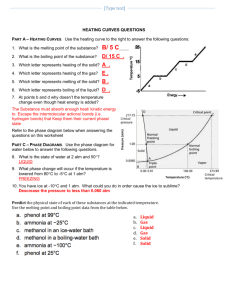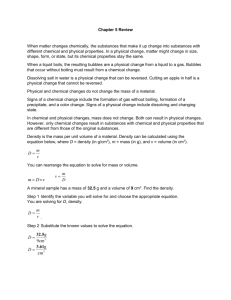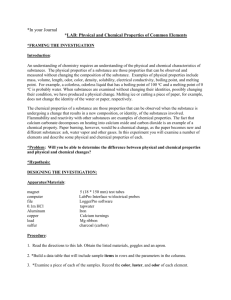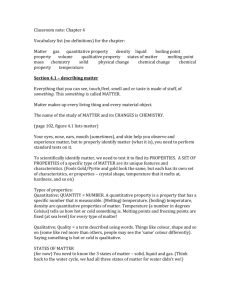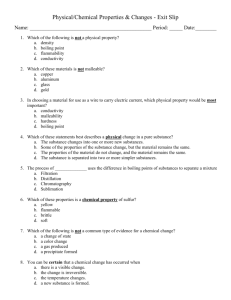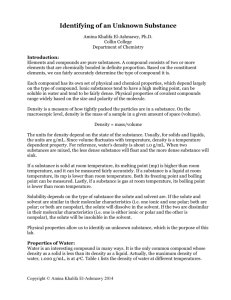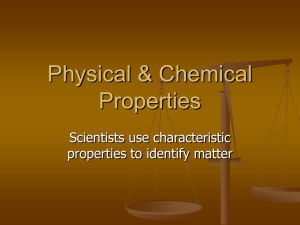DIY 2 - Alvin ISD
advertisement
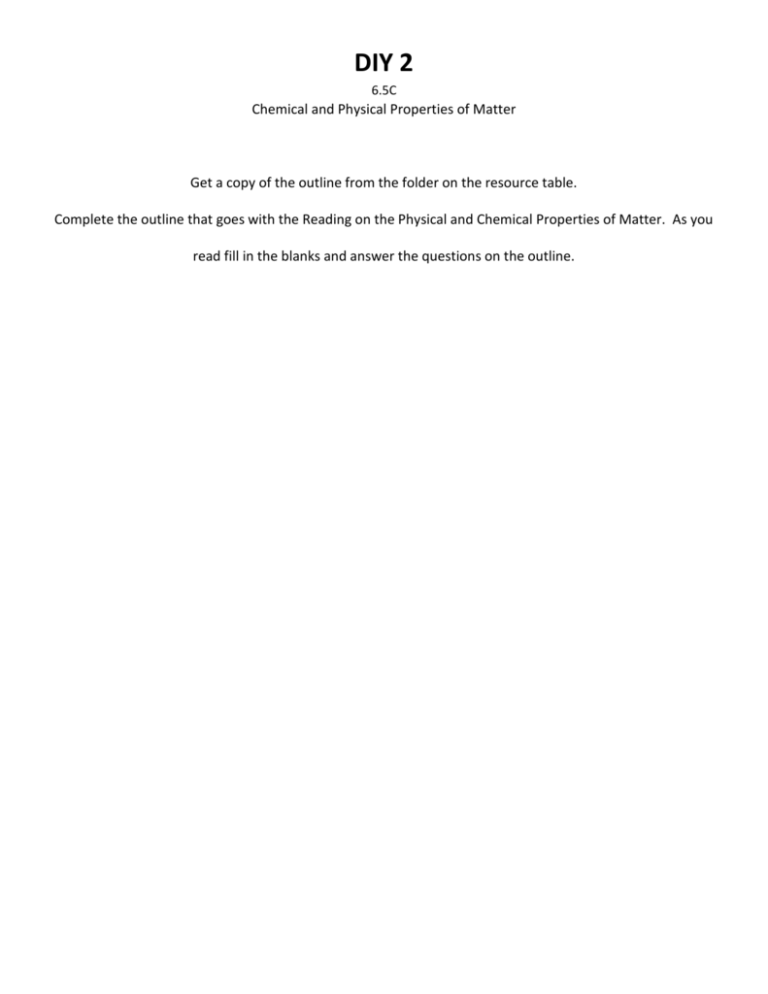
DIY 2 6.5C Chemical and Physical Properties of Matter Get a copy of the outline from the folder on the resource table. Complete the outline that goes with the Reading on the Physical and Chemical Properties of Matter. As you read fill in the blanks and answer the questions on the outline. CHEMICAL vs PHYSICAL PROPERTIES OF MATTER PHYSICAL PROPERTIES It’s a busy day at the state fair as you and your classmates navigate your way through the crowd. While you follow your teacher, you can’t help but notice the many sights and sounds that surround you. Eventually, you fall behind the group as you spot the most amazing ride you have ever seen. You inspect it from one end to the other. How will you describe it to the group when you catch up to them? What features will you use in your description? Perhaps you will mention that the ride is large, blue, and made of wood. These features are all physical properties, or characteristics, of the ride. A physical property is a characteristic you can observe without changing or trying to change the composition of the substance. How something looks, smells, sounds, or tastes are all examples of physical properties. Appearance Some physical properties describe the appearance of matter. You can detect many of these properties with your senses. For example, you can see the color and shape of the ride at the fair. You can also touch it to feel its texture. You can smell the odor or taste the flavor of some matter (You should never taste anything in the laboratory.) State To describe a sample of matter, you need to identify its state. Is the ride a solid, a liquid, or a gas? This property, known as the state of matter, is another physical property that you can observe. The ride, your chair, a book, and a pen are examples of matter in the solid state. Milk, gasoline, and vegetable oil are examples of matter in the liquid state. The helium in a balloon, air in a tire, and neon in a sign are examples of matter in the gas state. Perhaps you are most familiar with the three states of water. You can drink or swim in liquid water. You use the solid state of water, which is ice, when you put the solid cubes in a drink or skate on a frozen lake. Although you can’t see it, water in the gas state is all around you in the air. Size Dependent Properties Some physical properties depend on the size of the object. Suppose you need to move a box. The size of the box would be important in deciding if you need to use your backpack or a truck. You can begin by measuring the width, height, and depth of the box. If you multiply them, you calculate the box’s volume. The volume of an object is the amount of space it occupies. Another physical property that depends on size is its mass. Recall that the mass of an object is a measurement of how much matter it contains. A bowling ball has more mass than a basketball. Weight is a measurement of force. Weight depends on the mass of the object and on gravity. If you were to travel to other planets, your weight would change but your size and mass would not. Size Independent Properties Another physical property, density, does not depend on the size of an object. Density measures the amount of mass in a given volume. To calculate density of an object, divide its mass by its volume. The density of water is the same in a glass as it is in a tub. Another property, solubility, also does not depend on size. Solubility is the number of grams of one substance that will dissolve in 100 g of another substance at a given temperature. The amount of drink mix that can be dissolved in 100 g of water is the same in a pitcher as it is when it is poured into a glass. Size dependent and independent properties are shown in the table below. Melting and Boiling Point Melting and boiling point also do not depend upon an object’s size. The temperature at which a solid changes into a liquid is called its melting point. The temperature at which a liquid changes into a gas is called its boiling point. The melting and boiling points of several substances, along with some of their other physical properties, are shown in the table below. Behavior Some matter can be described by the specific way in which it behaves. For example, some materials pull iron toward them. These materials are said to be magnetic. The lodestone is a rock that is naturally magnetic. Physical Properties Dependent of sample size Mass, weight, volume Independent of sample size Density, melting/boiling point, solubility, ability to attract a magnet, state of matter, color Physical Properties of Substances at Normal Temp. and Pressure Substance Bromine Chlorine Mercury Neon Oxygen Color Red-brown Yellowish Slivery white Colorless Colorless State Liquid gas Liquid Gas Gas Density (g/cm3) 3.12 0.0032 13.5 0.0009 0.0014 Melting Point (oC) -7 -101 -39 -249 -218 Boiling Point (oC) 59 -34 357 -246 -183 CHEMICAL PROPERTIES Some properties of matter cannot be identified just by looking at a sample. For example, nothing happens if you look at matches. But if someone strikes the matches on a hard, rough surface they will burn. The ability to burn is a chemical property. A chemical property is a characteristic that cannot be observed without altering the substance. Matches are permanently changed after they are burned. Therefore this property can be observed only by changing the composition of the match. Another way to define a chemical property, then, is the ability of a substance to undergo a change that alters its identity. You will learn more about changes in matter in the following section. Are you reading? Part I: Outline A. B. ___________________________ property - characteristic that can be observed without changing the composition of the substance a. ________________________ includes things that can be observed with the senses. b. Substances can be in liquid, solid, or gas ______________________. c. Volume and mass are _________________________________________ that can describe physical properties. d. ____________________ point and boiling point are physical properties of a substance. e. ____________________ describes the way some substances behave. ____________________________ property – characteristic that cannot be observed without altering the substance. a. Ability to ___________________. b. Cannot be observed without ___________________ substances. c. Matches are ________________ changed after they are burned. Part II: Short Answer – Write answers in your notebook 1. What physical properties could you use to describe a baseball? 2. How are your senses important to identifying physical properties of matter? 3. How is density related to mass and volume? Explain and write an equation. 4. Describe a chemical property in your own words. Give an example. 5. Why do some properties of matter depend on the amount of matter present in the sample?

